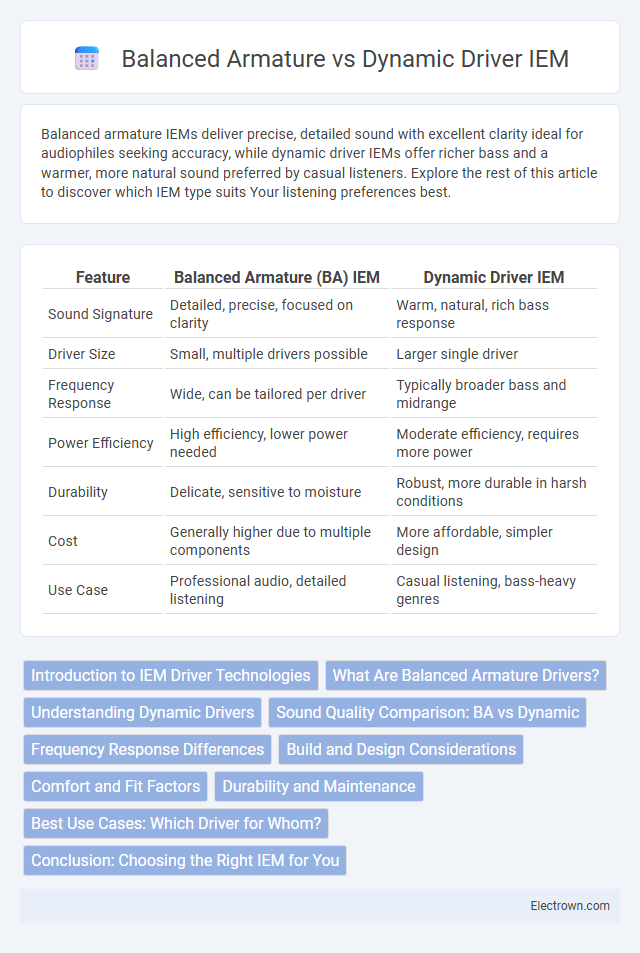Balanced armature IEMs deliver precise, detailed sound with excellent clarity ideal for audiophiles seeking accuracy, while dynamic driver IEMs offer richer bass and a warmer, more natural sound preferred by casual listeners. Explore the rest of this article to discover which IEM type suits Your listening preferences best.
Table of Comparison
| Feature | Balanced Armature (BA) IEM | Dynamic Driver IEM |
|---|---|---|
| Sound Signature | Detailed, precise, focused on clarity | Warm, natural, rich bass response |
| Driver Size | Small, multiple drivers possible | Larger single driver |
| Frequency Response | Wide, can be tailored per driver | Typically broader bass and midrange |
| Power Efficiency | High efficiency, lower power needed | Moderate efficiency, requires more power |
| Durability | Delicate, sensitive to moisture | Robust, more durable in harsh conditions |
| Cost | Generally higher due to multiple components | More affordable, simpler design |
| Use Case | Professional audio, detailed listening | Casual listening, bass-heavy genres |
Introduction to IEM Driver Technologies
Balanced armature and dynamic driver technologies represent the two primary types of in-ear monitor (IEM) drivers, each with unique mechanisms and audio characteristics. Balanced armature drivers use an electromagnetic armature to move a diaphragm, delivering precise and detailed sound ideal for clarity and instrument separation. Dynamic drivers function like tiny speakers, using a voice coil attached to a diaphragm to produce powerful bass and a natural, fuller sound, making them suitable for diverse listening preferences in Your audio setup.
What Are Balanced Armature Drivers?
Balanced armature drivers are specialized micro-speakers designed to deliver precise and detailed sound by using an armature suspended within a magnetic field that moves to produce audio signals. These drivers excel in reproducing mid and high frequencies with clarity, making them ideal for in-ear monitors (IEMs) used by audiophiles and professionals. Unlike dynamic drivers that rely on a diaphragm and coil system, balanced armature drivers offer greater efficiency and compact size, enabling multi-driver configurations for enhanced sound tuning.
Understanding Dynamic Drivers
Dynamic drivers in IEMs use a voice coil attached to a diaphragm that moves air to produce sound, delivering powerful bass and natural audio reproduction. Compared to balanced armature drivers, dynamic drivers excel in handling low frequencies with greater impact and warmth. When choosing your IEMs, understanding that dynamic drivers typically offer a more full-bodied sound helps in selecting the right earphones for bass-rich music genres.
Sound Quality Comparison: BA vs Dynamic
Balanced armature (BA) drivers excel in delivering precise and detailed sound with a clear midrange and impressive treble response, making them ideal for genres requiring vocal clarity and instrument separation. Dynamic drivers typically produce a richer, fuller bass and more natural soundstage, offering a warmer and more immersive listening experience suited for bass-heavy music. Comparing sound quality, BA-driven IEMs emphasize accuracy and articulation, while dynamic driver IEMs prioritize depth and warmth, resulting in distinct sonic profiles catering to different audiophile preferences.
Frequency Response Differences
Balanced armature IEMs typically deliver a more precise and focused frequency response, excelling at mid and high frequencies with greater clarity and detail. Dynamic driver IEMs often provide a wider, more natural frequency range, especially in the low-end bass, producing richer and deeper sound. Your choice depends on whether you prioritize detailed treble or impactful bass performance in your listening experience.
Build and Design Considerations
Balanced armature IEMs feature compact, intricate drivers designed for precise audio reproduction, often resulting in a sleeker and lighter build compared to dynamic driver IEMs, which typically use larger, diaphragm-based drivers requiring more space. The design of balanced armature IEMs allows for multiple drivers to be packed into a small shell, providing enhanced frequency response and detail, while dynamic drivers prioritize durability and a robust bass response with simpler construction. Choosing between these depends on your preference for detailed sound with a lightweight fit or a powerful, fuller sound with potentially bulkier design.
Comfort and Fit Factors
Balanced armature IEMs typically offer a lightweight design that enhances comfort during extended use, making them ideal for users who prioritize fit precision. Dynamic driver IEMs can be bulkier due to larger components, which might affect comfort and secure fit, especially during physical activities. Your choice should consider ear anatomy and wearing preferences to ensure an optimal balance of sound quality and comfort.
Durability and Maintenance
Balanced armature IEMs typically offer greater durability due to their solid-state design, with fewer moving parts prone to wear and tear. Dynamic driver IEMs, featuring a diaphragm and coil, may require more frequent maintenance to address issues like diaphragm fatigue or coil damage. Proper cleaning and avoiding excessive moisture are critical for maintaining long-term performance in both types.
Best Use Cases: Which Driver for Whom?
Balanced armature IEMs excel in delivering precise, detailed sound ideal for audiophiles and professionals requiring accurate monitoring. Dynamic driver IEMs offer robust bass response and are perfect for casual listeners or those who prefer a warmer, more punchy sound signature. Your choice depends on whether you prioritize clarity and detail or powerful bass performance in various listening environments.
Conclusion: Choosing the Right IEM for You
Balanced armature IEMs deliver precise, detailed sound ideal for clarity and instrument separation, while dynamic driver IEMs offer fuller bass and a warmer, more natural soundstage. Your choice depends on whether you prioritize accuracy for critical listening or a richer, immersive audio experience. Consider your listening preferences, music genres, and usage scenarios to select the IEM that best suits Your audio needs.
balanced armature vs dynamic driver iem Infographic

 electrown.com
electrown.com